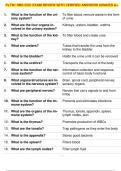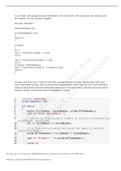PLTW: HBS EOC EXAM REVIEW WITH VERIFIED ANSWERS GRADED A+
1. What is the function of the uri- To filter blood, remove waste in the form
nary system? of urine
2. What are the four organs in- Kidneys, ureters, bladder, urethra
volved in the urinary system?
3. What is the function of the kid- To filter blood and create urea
ney?
4. What are ureters? Tubes that transfer the urea from the
kidney to the bladder
5. What is the bladder? Holds the urine until it can be removed
6. What is the urethra? Transports the urine out of the body
7. What is the function of the ner- Information collection and response,
vous system? control of basic body functions
8. What organs/structures are in- Brain, spinal cord, peripheral nerves,
volved in the nervous system? sensory organs
9. What are peripheral nerves? Nerves that carry signals to and from
limbs
10. What is the function of the im- Prevents and eliminates infections
mune system?
11. What are the organs of the im- Thymus, tonsils, appendix, spleen,
mune system? lymph nodes, skin
12. What is the thymus? Promotes production of WBCs
13. What are the tonsils? Trap pathogens as they enter the body
14. What is the appendix? Stores good bacteria
15. What is the spleen? Filters blood
16. What are the lymph nodes? Filter lymph fluid
,PLTW: HBS EOC EXAM REVIEW WITH VERIFIED ANSWERS GRADED A+
17. What is the function of the diges- To break down food into nutrients to fuel
tive system? the body
18. What are the organs of the diges- Teeth/tongue, pharynx, esophagus,
tive system? stomach, small intestine, large intestine,
rectum, anus, gall bladder, liver
19. What is the pharynx? Connects the mouth to the esophagus
20. What is the rectum? The final section of the large intestine
21. What is the anus? Part of the body from which stool is re-
leased
22. What is the gall bladder? Small membranous sac that stores bile
and releases it into the large intestine
23. What is the liver? Makes bile for the small intestine
24. What is the function of the respi- Takes in oxygen for cells and removes
ratory system? cellular CO2 waste.
25. What are the organs of the respi- Nasal cavity, pharynx, larynx, trachea,
ratory system? epiglottis, bronchi,, alveoli
26. What is the function of the car- Moves blood throughout the body
diovascular system?
27. What organs/structures make up Atria, ventricles, arteries, arterioles,
the cardiovascular system? veins, venules, capillaries
28. What is the function of the en- Responsible for secretion of hormones
docrine system?
29. anterior front
30. ventral front (belly)
31. posterior back
, PLTW: HBS EOC EXAM REVIEW WITH VERIFIED ANSWERS GRADED A+
32. dorsal back
33. superior higher, above
34. inferior lower, below
35. lateral side
36. medial toward the middle
37. proximal on limb, nearer to attachment point
far
38. distal on limb, farther from attachment point
near
39. superficial more external, surface of the body
40. deep more internal
41. What does epithelial tissue do? COVERS
lines organs and body cavities
42. How is epithelial tissue struc- Layers (one kind of cells inside, different
tured? kind outside)
43. What does muscle tissue do? MOVES
makes up all muscles, including the
heart
44. How is muscle tissue struc- Long and narrow so they can contract to
tured? allow movement
45. What does nervous tissue do? SIGNALS
includes neurons
46. How is nervous tissue struc- long axons to allow signals to travel dis-
tured? tances, branches for connections
47. What does connective tissue do? JOINS
adipose (fat), blood, bone, cartilage, etc.





